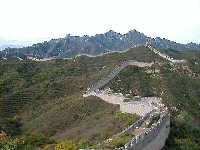Further construction and extensions were made in the successive Northern Wei,
Northern Qi (386-581) and Sui (581-618) dynasties.
 The present Great Wall in Beijing mainly consists of remains from the Ming
Dynasty (1368-1644). During this period, brick and granite were used when the
workers laid the foundation of the wall, and sophisticated designs and passes
were built in places of strategic importance. To strengthen military control of
the northern frontiers, Ming authorities divided the Great Wall into nine zones,
placing each one under the control of a Zhen (garrison headquarters). The Ming
Wall starts from Yalujiang River (in today's Heilongjiang Province), via today's
Liaoning, Hebei, Inner Mongolia, Shanxi, Shaanxi, Ningxia provinces, to Guansu.
It's total length reaches 12,700 li (over 5,000 km). The Shanhaiguan Pass and
Jiayuguan Pass are two well-preserved sites located at either end of the Wall.
The present Great Wall in Beijing mainly consists of remains from the Ming
Dynasty (1368-1644). During this period, brick and granite were used when the
workers laid the foundation of the wall, and sophisticated designs and passes
were built in places of strategic importance. To strengthen military control of
the northern frontiers, Ming authorities divided the Great Wall into nine zones,
placing each one under the control of a Zhen (garrison headquarters). The Ming
Wall starts from Yalujiang River (in today's Heilongjiang Province), via today's
Liaoning, Hebei, Inner Mongolia, Shanxi, Shaanxi, Ningxia provinces, to Guansu.
It's total length reaches 12,700 li (over 5,000 km). The Shanhaiguan Pass and
Jiayuguan Pass are two well-preserved sites located at either end of the Wall.
Today, the Wall has become a must-see for every visitor to China. Standing on
top of a beacon tower and looking down at this giant spiraling dragon and
accompanying majestic views, one can't help but be awestricken.
Sections
The Great Wall, an extensive bulwark erected in ancient China, is one of the
largest construction projects ever carried out. The Wall's length totals about
4,500 miles (7,300 km) from east to west from the Shanhaiguan Pass near Bohai
(Gulf of Bohai) to Jiayuguan Pass (in modern Gansu province), traversing
Liaoning, Hebei, Tianjin, Beijing, Shanxi, Inner Mongolia, Shaanxi, Ningxia and
Gansu. Without its branches and other secondary sections, the wall extends for
some 4,160 miles (6,700 km), often tracing the crest lines of hills and
mountains as it snakes through the Chinese countryside.
The section of the Wall at Badaling is most famous due to its proximity to
Beijing City and extended restorations. The imposing Badaling Great Wall climbs
up and down and twists and turns along the high mountain ridges to fully display
the lofty efforts of ancient Chinese laborers.
More than 1,000 meters above sea level, the Badaling Great Wall occupies a
commanding and strategic position. It is a defensive outpost of the Great Wall
called "Bada" since it stretches in all directions.